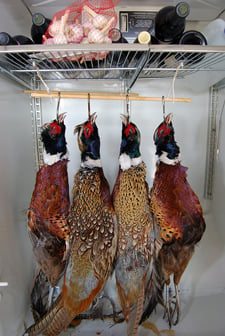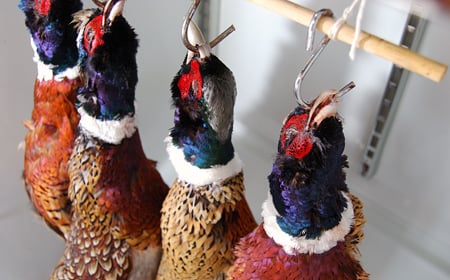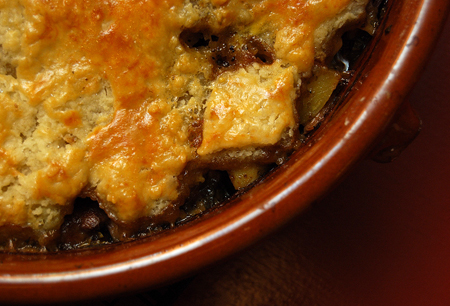As an Amazon Associate I earn from qualifying purchases.
I have for several years recoiled at the idea of hanging game birds. The idea of hanging shot pheasants or partridges undrawn and in the feathers for days and days just did not seem terribly hygienic or sane to me. Old texts wax rhapsodic about the sublime flavor of “high” game, which usually means pheasants and usually means birds that have hung for more than a week. This, I decided, was madness.
I was wrong.
I apologize for not posting in nearly a week, but life has been busy and I am in the middle of two experiments: One involving a pig’s head and various offal I will write about soon. The other has been a systematic look at the science of hanging game birds.
Nearly everyone who reads this space would probably agree with me that dry-aged beef is the finest expression of that meat. It is concentrated, savory and tender — and very expensive because dry-aging necessarily means a layer of crusty, slightly moldy ick on the outer edges of the meat. This is cut off before selling or serving.
Hanging beef — and especially venison — is important in part because beeves tend to be dispatched at about 18 months to 2 years old, old enough to get a tad tough on the teeth. A whitetail buck sporting trophy antlers is likely to be 3-6 years old. Why not hang pork, you say? Hogs are slaughtered young. Ditto with domestic chickens. Young animals are already tender, so that aspect of aging isn’t needed.
Enter the pheasant. A pheasant really is a “ditch chicken.” It is a close cousin of the domestic chicken and when eaten fresh has, as Brillat-Savarin puts it in his The Physiology of Taste, “nothing distinguishing about it. It is neither as delicate as a pullet, nor as savorous as a quail.” Those who have eaten fresh pheasant — and by fresh I mean un-hung — can’t help but thinking: “So what? This just seems like a slightly tough and slightly gamy chicken.” They’re correct, especially with farm-raised birds or those shot at a game preserve.
Plucking a pheasant is also less than a joyful experience, so I had shied away from them in favor of ducks, which are better tasting fresh and which pluck far easier. But our friend Peter invited us to the Camanche Hills Hunting Preserve last weekend to chase pheasants, and after about 6 miles of tramping around, we managed to put four birds in the bag.
Now after the Adventure of the Unkillable Pheasant, I was ready to get down to some serious pheasant business. That bird I did not hang, and while it came out well roasted simply, I knew there had to be something more to what LP De Gouy calls the “king of game birds … wild pheasant deserves a profound veneration.” I reckoned it must be in the hanging.
I put our four pheasants in the salami fridge, which is set at 55 degrees. One had a big open spot on it where the breast skin had been ripped, so that bird I plucked after just one day. More on him later.
* * *

The great Jean Anthelme Brillat-Savarin doesn’t give a timetable, but says, “the peak is reached when the pheasant begins to decompose; its aroma develops, and mixes with an oil which in order to form must undergo a certain amount of fermentation, just as the oil in coffee can only be drawn out by roasting it.” Sounds pretty hardcore.
Roy Wall wrote in 1945: “The flesh of either wild game or domesticated animals and fowl can certainly be improved by aging, but it is my opinion that there must be a limit to the aging process…aging in the open air for 10 days or a month, according to weather conditions, is, in my opinion, most beneficial to domestic and wild meat alike.”
Don’t freak out. Roy doesn’t specify what game he’s talking about there, and aging an old buck deer in proper conditions for a month isn’t such a crazy idea, although I’d prolly cut it down after two weeks. More recently, Clarissa Dickson Wright — one of the Two Fat Ladies, my favorite TV food personalities — says of pheasant: “Hang it you must, even if for only three days, for all meat must be allowed to rest and mature.” Clarissa’s preference is a week to 10 days.
The current Authoritative Source on All Things Meat is Englishman Hugh Fearnley-Whittingstall, who in his River Cottage Meat Book says “four or five days would be about right for me” if a bird is hung at 55 degrees.
This is what the food writers say, but to me that’s only a piece of the puzzle. What about science?
* * *
Fortunately science exists on the topic of hanging game birds. My best source is an Australian government publication that did some rigorous experiments. For example:
Pheasants hung for 9 days at 50°F have been found by overseas taste panels to be more acceptable than those hung for 4 days at 59°F or for 18 days at 41°F. The taste panels thought that the birds stored at 59°F were tougher than those held for longer periods at lower temperatures. Pheasants hung at 50°C became more ‘gamy’ in flavour and more tender with length of hanging.
Aha! One issue solved. Food writers rarely talk about temperature of hanging because most of them think about hanging pheasants outside, which is fine if you don’t live in California; even now it is too warm to properly hang game. It seems 50 degrees is ideal, and the 55 degrees my fridge is set at is acceptable.
Furthermore, an English study from 1973 found that clostridia and e. coli bacteria form very rapidly once you get to about 60 degrees, but very slowly — and not at all in the case of clostridia — at 50 degrees.
That same study found that field care of the birds is vital. Under no circumstances should you allow pheasants to pile up in warm conditions because doing so will slow cooling so much that the dead birds will develop bacteria in their innards. This is no bueno.
All the bacteria and taste tests converge on two things: 50-55 degrees and 3-7 days. That’s your takeaway, folks.
Left undiscussed is the importance of feathers and innards. Brillat-Savarin speaks about a mysterious “oil,” and Wall talks about bacterial decomposition. Here’s my take: The feathers provide protection for the skin against drying out during aging. Pluck the feathers right away and you can still age the bird, but the skin will be unacceptably dried out and unusable.
As for the guts, I am on the fence here. I think they do add something: Fish guts will affect the fillets because of the animal’s digestive enzymes. No reason to think land animals aren’t the same way, although at 50-55 degrees this is going to take some time to develop — for what it’s worth, a pheasant’s body temperature runs about 105 degrees.
Yet, when I plucked and gutted my pheasants this week I noticed two things: One, they were pretty dry inside, and two, the innards in three of the four birds looked fine and wholesome, not ratty and stinky. Maybe this je ne sais quoi does not appear until later.
* * *
All of which brings me to my own first experiments with hanging pheasants. Like I mentioned before, I had one damaged bird I let hang for only a day. This bird’s body was drier and tighter than a fresh-killed bird, and I dry-plucked it because of the damage.
This pheasant went into a pheasant and pork pie, which turned out to be an outstanding dish. Hat tip to Fergus Henderson for the inspiration on this one. How was the pheasant? I noted two things: One, the bird browned better (less moisture?), and it was more flavorful — even after just one day.
That left three birds. I plucked the next one at three days. This is the beginning of the sweet spot in the Australian study. I noticed that this bird was pretty limp, but there was no bad smell and the fat and giblets looked pristine. I was, honestly, pretty shocked. I jointed this bird because that’s what I do with most pheasants; the legs and thighs always need more time than the breast.
The aging really came into play with the breast. It was soft, not unpleasantly so, but definitely less firm than the day-old bird or a fresh one. Hmmm…
Then it hit me: These Camanche pheasants are pen-raised and have only been wandering around wild for days or weeks (months at the most). They were all young birds. I had originally planned to leave one bird for a full week, but scotched that idea immediately. I plucked the next two birds at 3 1/2 days and 4 days. I kept both whole.
A few things you should know. Don’t try to wet-pluck an aged pheasant as I instruct you to here. You must dry-pluck these birds because the skin gets looser and scalding did not seem to help one bit with the feathers. It was a major bummer to scald one bird and rip some of the skin. Dry-plucking, you should be warned, sucks. It takes forever, but is worth it for the results.
To eat the giblets or not? I’d say go for it for birds up to three days, if they have not been shot up. Any sign of ickiness in the innards and toss them at once. One way to tell if you are unsure is to render the fat the way you would with a duck. If it stinks, toss it.
So, to wrap up, here’s what I found:
-
Keep your birds as cool and as separate as possible in the field. Use a game strap, not the game bag in your vest. Separate your birds in the truck or put them in a cooler — do not get them wet!
-
Hanging your birds by the neck or feet does not matter, as several studies has shown.
-
Hang the birds between 50-55 degrees for at least three days, up to a week with an old rooster. Old roosters will have horny beaks, blunt spurs and feet that look like they have been walked on for quite some time. They will also have a stiff, heavy keelbone. Hen pheasants only need 3 days.
-
Do not hang any game birds that have been gut-shot or are generally torn up. Butcher these immediately and use them for a pot pie.
-
Dry-pluck any bird that has hung for more than 3 days.
-
Wash and dry your birds after you pluck and draw them. Only then should you freeze them.
There is a final test I have yet to do: Eat the birds. As this is Thanksgiving week and I am about to head out for a major duck hunt, this will have to wait. I will be sure to report back when I cook them. UPDATE: The birds were fantastic – much more interesting in flavor, a little gamey, but in a good way.







Hi Hank,
I’m from South Dakota and came home with several roosters after the opener this weekend. I have them hanging outside, and the weather here is roughly mid-fifties during the day, but getting down to low 30s at night. The low in two nights is 27. Is this too cold to effectively age my pheasants? Does the fluctuating temperature have ill-effects?
Thanks for your help!
Clara: Nope, they are not drained of blood. As for chickens, I bet you can hang them, too. But since most chickens are killed at a young age, I don’t think it’d help much. But I would most definitely hang an old stewing hen or rooster.
Hi Hank,
Your article was wonderfully informative. However, I was wondering if you could clarify one thing: the birds are drained of their blood before hanging, yes?
Did any of your sources talk about hanging domesticated chickens? I find that chicken has a strong, gamey taste that usually turns me off. Maybe this process would help develop the flavour into something more tasty (to me)
Thanks so much for posting this!
What an informative website! I did not find it soon enough, the first batch of 4 huns and 3 pheasant I had plucked right away. I was lucky to receive some from a friend, and happy to have a new experiment. I brined and smoked them, and they were so delicious. Now after studying, and getting my 2nd batch of birds, the good ones are hanging in my garage (47 by day). The Huns are on day 3, so I’ll pluck them, and check the pheasant in a couple days. The shot up ones I skinned out right away. I am anxious to see the difference which hanging yields.
Thanks so much for your expertise! You’ve helped many hunters and chefs, including game bird novices like me! This site rocks!
I am glad that you made this article. I am from the Czech Republic, I´ve been to America and even shot a turkey there, but that is another story. Back in the old days people here would hang a partridge or a hare shot in the fall and use it in the spring. And the recent ideas on this were not to hang game at all, now I know, that what is important is the tempereture. Thanks
Very interesting article, possibly read to late, as I have hung my brase of pheasants for 5 days, outside where it has been between minus 2 and 6 degrees, but the smell when I opened up the cock was VERY strong and unpleasant, so I am now debating what to do with the meat. thanks for the tips.
Van Dao: Yes, you can age in the fridge, but the temperature and humidity will be off, so it is not ideal.
Bernard: Don’t hang your birds longer than 7 days. Hang whole – in feathers and with the guts in. If you go longer than a week, the bird may still be tasty, but it will smell funky… and not in a good way.
It’s about 30 degrees outside, 40 in my garage. I just shot two pheasant and have them hanging in the garage. Would a week or two be enough. Also, do I need to do any dressing or cleaning? I take it from the above that as long as the gut is not broken, leaving them hang is just fine.
I’m so sppreciative of the information you provided, extremely useful. I actually bought a live phesant and killed and chilled it immediately, with the intention of aging it. All I knew was that it was common practice in the Old World, but did not know the specific time and temperature to do so. This will be my Thanksgiving bird as I favor game birds over domesticated birds any day.
Here’s my question to you: Can you age a pheasant in the fridge, without hanging it? How vital is it to hang it vs. setting it down in the fridge?
Any feedback would greatly be appreciated.
Cheers,
Van
Great post. Searched high and low to find this information and I think this has got to be the best information I’ve run across on fish and game processing since Jocosta Innes wrote “The English Country Kitchen.”
I’ve got four fat mallards hanging in about 2-3 C, foggy and snotty weather. Shot them above a pea field a couple days ago; I’m in Alberta, Canada.
When I was a teenager in British Columbia, I aged sea ducks (scoters) for two or three days at about the same conditions, then skinned and de-fatted them (they’d been eating mussels) and they tasted totally alright even though I was a newb. Then I forgot about it. It’ll be interesting to see how these turn out. We shot 22 geese at the beginning of September and unhung, they were delicious — they were stuffed with wheat and barley.
BTW: Re: your Manitoba hunt, use WestJet. Way easier and cheaper to haul fish and game. We flew a pile of seafood between the coast and Alberta, and all they really ask for is a waterproof box. They fly to L.A.
Well, there has to be an exception to every rule, and I disagree with you on the taste of aged birds. And it is not for the lack of trying them. The old guys I used to hunt with did this stuff as well, and I have eaten plenty of it, and liked it.
Hey, to each their own. I pluck my waterfowl while afield ( I carry a bag) to cool them, and I rinse them well before cooking or storing.
But, for the record, I like to skin and cut up my venison the same day I shoot it, and prefer fresh beef to ‘aged’.
I simply prefer the taste of fresh meat, any way you slice it. (sorry).
Interesting post though, I really enjoyed reading it.
Hank,
What would be the longest that I could hang pheasants before it becomes no good. My wife likes a very gamey taste but I want to make sure they are not rotten. is two weeks too long?
For the record, (or your amusement…) 5 days indoors at 75F is way out 🙁
On Monday, my boss very kindly gave me a brace of pheasants he had in the boot of his car after I asked how his shooting trip had gone at the weekend. He said I should be sure to eat them within a week as the taste would become too strong but he may have forgotten that I live in a flat with my pet snakes and would therefore be hanging them indoors at a warm room temperature.
For what it’s worth, I was always going to be doing some research before risking eating them… but Fate had nevertheless decided to teach me a lesson in hygienic food storage: if in doubt, look it up on the internet ASAP.
The following morning I crashed the car and since work was busy after the holidays, I decided to stay in a hotel near the office for the rest of the week rather than taking the train.
This evening, the unmistakable stench of dead stuff greeted me at the door. By the time my stomach contents had returned to their normal equilibrium, the smell’s origin had already been deduced.
What did take me by surprise was the force with which the female pheasant must have expelled her own stomach contents to leave such a fine ochre sheen on the walls, door and carpet.
The neighbours across the hall must have thought I’d killed someone and fled the country and they’re now about to see me leave in the middle of the night carrying a black bin bag.
But I will close my tale with the happy image of a four-year old cornsnake waiting patiently in the same room, being as good gold, all week, nose pressed hopefully to the side of his tank, with his eyes fixed on the most gorgeous meal he had ever seen.
Thanks, for your quick reply, I think you spelled out what I had thought.. Hence why I read this on hanging game. Know now for future reference…
On the snipe & woodcock, Iv met alot of snipe especially with this long cold snap, but don’t bother shooting as have’nt a nice recipe. woodcock only met one myself, “so far”
On traveling to Ireland your more than WELCOME.
George: 10 days?! That is an awful long time for a little teal. Remember the smaller the bird, the shorter the hang time.
That said, 4 degrees C is pretty cold. Give it a go and see would be my advice. I would not eat the innards, though. 10 days is too long for them to sit inside the bird.
Pluck the bird, toss the innards, rinse it well in cold water and dry it well. Take a deep sniff: It should smell gamey but not rotten (you’ll know the difference). If it smells funky in a way that your mind says, “Hmmm, I bet this would taste wonderful,” try it. But if your senses say ROTTEN!! Toss them.
I don’t like hanging ducks and geese more than a few days because they have fat, which can go rancid — at least California waterfowl are fatty. Dunno about Irish ones.
BTW, would LOVE to travel to Ireland to shoot snipe and woodcock someday – my favorite game birds at the table.
hi hank, im from Ireland & have 2 teal hanging outside in a cladding shed for the last 10 days where temperatures have been freezing & not above 4 deg c. would they be ok? I have cleaned a pheasant that was hanging for 7 days in the same place and there was ice inside when i cleaned it. Any comments welcome. reggards
Russ: 35 degrees is pretty cool but not too bad; I like hanging a little less time at a little warmer temperature — about 45 degrees.
Graham: I assume you mean 50 degrees Fahrenheit, right? Seven days at that temperature is a little long; I’d normally do just 3-4 days in that. However, it is not uncommon to hang pheasants that long in that temperature. You did rinse them well in cold water and then dried them off after plucking and gutting, yes? Are they still smelly?
There is a fine line between aging and rot, and I suspect you are close to it. As for eating the pheasants, use your best judgment. I’ve heard people rhapsodize about week-old, smelly pheasants that cook up beautifully — but I’ve also heard about people who stank up their whole kitchen cooking a semi-rotted bird. Whatever you do, cook the pheasant past 165 degrees F, just to be safe.
Hank: Excellent site. I was given a brace last week. kept in the cellar at around 50 degrees C, Today I plucked and gutted both, skin tore a little but ok. They were a little smelly, but they’re in the fridge now and waiting to be cooked in 2 days time. that is 7 days hung and 2 in the fridge. My question is, is that smell just the ‘Gamey’ quality or is it too long hung? all the best Hank
Graham
Took two birds today. Over coffee this morning before we headed out to the fields, I told my buddies that I planned on hanging birds ungutted for a few days. They thought it was the wrong thing to do. I’ve been doing some reading on it on your site and some others. Very excited to try this, they are hanging in the fridge now. One question I have is the effects of 35 degrees or so out in the garage. I am sure my wife is fine with me using our extra fridge but just checking. Thanks for all the info.
Joy: No, leaving thawed plucked and gutted pheasants will not recreate the effect of hanging. I agree with your husband. Eat them sooner.